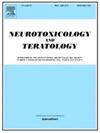The relationships of prenatal cocaine exposure, postnatal lead exposure, and victimization to aggressive behavior/delinquency in adolescence
IF 2.8
3区 医学
Q3 NEUROSCIENCES
引用次数: 0
Abstract
Introduction
Prenatal cocaine exposure (PCE) can alter the monoaminergic neurotransmitter system in the fetal brain related to emotional and behavioral regulation. PCE has been associated with high rates of aggression and delinquency, risk for victimization, and multiple environmental stressors associated with a disadvantaged environment, including postnatal lead exposure. While postnatal lead exposure has also been linked to aggressive behavior/delinquency, little is known about the combined impacts of PCE and lead on behavior, nor how they interact with environmental stressors such as victimization.
Objectives
Assess the relationships of PCE, postnatal lead levels, and victimization to adolescent self-report of aggressive behavior/delinquency, controlling for other prenatal drug exposures and the quality of the caregiving environment.
Methods
At age 17, 336 adolescents (50 % PCE, 46 % male) reported their aggressive behavior/delinquency (AGG) on the Problem-Oriented Screening Instrument for Teenagers, and type of lifetime victimization on the Juvenile Victimization Questionnaire. Blood lead levels were measured at 2–4 years, and the Home Observation for the Measurement of the Environment – Early Adolescence at 15 years. Binomial logistic, multiple regression and mediation analyses examined group differences and relationships among variables.
Results
PCE, victimization (child maltreatment and peer/sibling victimization), and postnatal lead levels were each associated with higher AGG. Girls with PCE reported higher AGG than non-exposed girls while boys did not differ, and all adolescents with PCE reported more child maltreatment and peer/sibling victimization. Child maltreatment partially mediated the relationship between PCE and aggressive behavior/delinquency.
Conclusions
Recognition of the higher rates of maltreatment and peer/sibling victimization with PCE is important for intervention efforts, as each contributes to higher AGG. As PCE may be associated differentially with higher AGG in girls, gender-focused interventions should be considered while addressing the increased impact of victimization and postnatal lead levels on AGG in both PCE and NCE boys and girls.
产前可卡因暴露、产后铅暴露与青少年攻击行为/犯罪受害的关系。
产前可卡因暴露(PCE)可以改变胎儿大脑中与情绪和行为调节有关的单胺能神经递质系统。PCE与高攻击性和犯罪发生率、受害风险以及与不利环境相关的多种环境压力因素(包括产后铅暴露)有关。虽然产后铅暴露也与攻击性行为/犯罪有关,但人们对PCE和铅对行为的综合影响知之甚少,也不知道它们如何与环境压力源(如受害)相互作用。目的:在控制其他产前药物暴露和护理环境质量的情况下,评估PCE、产后铅水平和受害程度与青少年攻击行为/犯罪自述的关系。方法:在17岁时,336名青少年(女性占50 %,男性占46 %)在青少年问题导向筛查工具上报告了他们的攻击行为/犯罪(AGG),并在青少年受害问卷上报告了他们的终身受害类型。在2-4 岁时测量血铅水平,并在15 岁时进行环境测量的家庭观察。二项逻辑分析、多元回归分析和中介分析检验了群体差异和变量间的关系。结果:PCE、受害(儿童虐待和同伴/兄弟姐妹受害)和产后铅水平均与较高的AGG相关。患有PCE的女孩报告的AGG高于未暴露的女孩,而男孩则没有差异,所有患有PCE的青少年都报告了更多的儿童虐待和同伴/兄弟姐妹受害。儿童虐待在PCE与攻击行为/犯罪的关系中起部分中介作用。结论:认识到PCE患者较高的虐待率和同伴/兄弟姐妹受害率对干预工作很重要,因为它们都有助于提高AGG。由于PCE可能与女孩较高的AGG有不同的关联,在解决受害和产后铅水平对PCE和NCE男孩和女孩AGG的影响增加时,应考虑以性别为重点的干预措施。
本文章由计算机程序翻译,如有差异,请以英文原文为准。
求助全文
约1分钟内获得全文
求助全文
来源期刊
CiteScore
5.60
自引率
10.30%
发文量
48
审稿时长
58 days
期刊介绍:
Neurotoxicology and Teratology provides a forum for publishing new information regarding the effects of chemical and physical agents on the developing, adult or aging nervous system. In this context, the fields of neurotoxicology and teratology include studies of agent-induced alterations of nervous system function, with a focus on behavioral outcomes and their underlying physiological and neurochemical mechanisms. The Journal publishes original, peer-reviewed Research Reports of experimental, clinical, and epidemiological studies that address the neurotoxicity and/or functional teratology of pesticides, solvents, heavy metals, nanomaterials, organometals, industrial compounds, mixtures, drugs of abuse, pharmaceuticals, animal and plant toxins, atmospheric reaction products, and physical agents such as radiation and noise. These reports include traditional mammalian neurotoxicology experiments, human studies, studies using non-mammalian animal models, and mechanistic studies in vivo or in vitro. Special Issues, Reviews, Commentaries, Meeting Reports, and Symposium Papers provide timely updates on areas that have reached a critical point of synthesis, on aspects of a scientific field undergoing rapid change, or on areas that present special methodological or interpretive problems. Theoretical Articles address concepts and potential mechanisms underlying actions of agents of interest in the nervous system. The Journal also publishes Brief Communications that concisely describe a new method, technique, apparatus, or experimental result.

 求助内容:
求助内容: 应助结果提醒方式:
应助结果提醒方式:


